Three Editors in Chief: A Conversation
Earlier this year, the Horn Book's eighth (and current) editor in chief, Elissa Gershowitz, spoke with longtime editors in chief numbers six and seven: Anita Silvey (from 1985–1995) and Roger Sutton (from 1996–2021).
Earlier this year, the Horn Book's eighth (and current) editor in chief, Elissa Gershowitz, spoke with longtime editors in chief numbers six and seven: Anita Silvey (from 1985–1995) and Roger Sutton (from 1996–2021). Currently an adjunct professor at Simmons University, Silvey is an author (Everything I Need to Know I Learned from a Children's Book, Roaring Brook, 2009) and frequent lecturer and guest speaker. Editor Emeritus Sutton continues his lively and informative Talks with Roger and Publishers' Previews interview series for the Horn Book. For more on our previous editors in chief, visit hbook.com/story/horn-book-magazine-editors.
ELISSA GERSHOWITZ: Roger and Anita, I’m thrilled to be speaking with you both!
ANITA SILVEY: It has been a long time since three editors of the Horn Book have been in the same [virtual] room! Not since Paul and Ethel Heins and I were together in the 1980s. It’s great to reflect on my years at the Horn Book.
As a young girl, I read to my teddy bears and dreamed of being a teacher. Eventually, with a BS in education (Indiana University) and MA (University of Wisconsin), I arrived in Boston in 1970 with no job prospects. Fortunately, Ralph Woodward, publisher of children’s books at Little, Brown, hired me to be his assistant, and ten months later Paul Heins brought me over to the Horn Book. I still consider my time from 1971–1975 as the happiest years in my career. I had all the joy of working at the Horn Book — with few of the responsibilities.
Late in 1975 I left to work with a group of my friends on an independent review publication, Boston Review, that we had just founded. Then, a year later, I joined Walter Lorraine at Houghton Mifflin as marketing manager for children’s books. When Ethel retired in 1985, Thomas Todd, then-president of the Horn Book, asked me to return as editor of the Magazine. At that time, he said, “The devil you know is better than the one you don’t.”
EG: Roger, what was your path?
ROGER SUTTON: I had wanted to be a librarian since I was a little boy. I used to play library with my brothers, just as my brother, the late Father John, would make us play church. I grew up in Boston and went to college in California. I went to library school at the University of Chicago, but the year before I was a security guard at the Pomona (CA) Public Library. Two fabulous librarians shifted my focus to children’s librarianship.
At the University of Chicago, I met Zena Sutherland, who determined the trajectory of the rest of my entire career. I was her assistant. After library school, after I’d worked for about five years in public libraries, Betsy Hearne, who had succeeded Zena at the Bulletin of the Center for Children’s Books, called me back to work at the Bulletin in 1988. And then when Betsy decided she wanted to teach full time, I became its editor. I wasn’t the editor for very long — maybe two or three years — when the Horn Book called. Anita had left, and they asked me to apply. I showed up at the Horn Book in spring of 1996.
AS: I think that Zena, and Lillian Gerhardt [School Library Journal’s former longtime editor in chief], were two of the most incredible people I met in the field. Because of Zena’s depth of knowledge, her standards, and her humanity, I wanted to grow up to be like her. She was someone who set the standard for the field. You were fortunate to have worked with her.
RS: I learned a lot from Zena.
AS: There were legendary figures in most of the major library systems in the country, and they trained a lot of young librarians: Anne Carroll Moore at New York Public in the early part of the twentieth century and then later Augusta Baker. Alice M. Jordan at the Boston Public Library. Carolyn Field of the Philadelphia Public Library. People with strong personalities who passionately cared about books.
Ruth Hill Viguers, the Horn Book’s third editor, was also considered one of those Library Lions. She had to retire from the Horn Book because of age — and she was furious about it!
RS: Back when it was usual to fire people because they turned sixty-five. And, oh my God, Anita, we’re both older than that now! I remember you telling me about Ethel Heins literally having her foot in the door as you tried to close it once.
AS: Well, it’s hard to walk away from power.
EG: When I came to the Horn Book, in 2006, Roger was a personality. It was intimidating! But the reality was not a hierarchical system with one person at the top. Everybody was expected to participate, and everything we learned was very naturally taught. It led to a highly collaborative atmosphere, and it really taught people how to be good Horn Book critics.
AS: I would argue that the most important thing Roger and I have done as editors is train the next generation of critics, writers, editors. When I think of my time as editor, I remember the people like Martha Parravano, Jennifer Brabander, and Lolly Robinson — who then stayed with Roger for years.
RS: That’s something I have to really thank Anita for because I walked into this job knowing children’s books and reviews editing, but nothing about articles or working with authors. Anita left behind not only great systems, but also people who knew what they were doing and who cared about what they were doing. In my first few years, they all knew way more about what I should be doing than I knew. And they taught me that very gracefully, graciously, diplomatically.
 AS: Both Roger and I came from a system of private ownership of the Horn Book. I had worked with five owners at one time. Arnold and Bill Manthorne, descendants of Bertha Mahony Miller (at right); Betsy Halbrooks, former business manager; and Tom and Duncan Todd.
AS: Both Roger and I came from a system of private ownership of the Horn Book. I had worked with five owners at one time. Arnold and Bill Manthorne, descendants of Bertha Mahony Miller (at right); Betsy Halbrooks, former business manager; and Tom and Duncan Todd.
RS: For me it was down to two — just the Todds, who were part of the printing dynasty that produced the Horn Book.
AS: I had to spend a lot of time in shuttle diplomacy between the five owners, who did not always see eye to eye. There was not a lot of harmony, but we did engage in off-kilter choral singing. Eventually we got the Todd duet and that made decision making a little easier.
EG: Where were the physical offices when you both started, and what are some memorable office stories?
AS: My first desk was outside Paul Heins’s door in the Copley Square office. So many authors would visit. Ezra Jack Keats, Bob McCloskey, David McCord, P. L. Travers, who was such a character, like Mary Poppins herself.
At that point, the Horn Book kept a copy of every book they’d ever reviewed. Since titles were organized by publisher, you could get an education in fifty years of publishing history by walking around the room. Every night I carried books home; every afternoon Paul and I would have tea and talk about what I had read.
My favorite office, quite elegant, was at 11 Beacon Street, right across from the Boston Athenaeum. We had a wonderful view of Beacon Hill. There was a huge, circular area where we could invite people and host events. We would hold all-day reviewers’ meetings, bringing in the review staff to discuss and argue about the books for the next issue. If you were an assistant during that time, you hated this meeting with a passion. What I learned at those meetings was extraordinary. So was the exhaustion.

L to R: Margaret Bush, Ann Flowers, Lauren Adams, Anita Silvey, Hannah Zeiger, Martha Parravano, Mary Burns, Maria Salvadore, and Elizabeth Watson at a reviewers' meeting.
RS: I got rid of that meeting as soon as I could. They could be a lot of fun, and I would learn things, but the amount of work that went into it as opposed to what editorially we could squeeze out of it just didn’t seem worth it to me.
AS: Well, you had to have a high tolerance for pain. You had to think that the pain was worth it in terms of final reviews.
EG: I promised that I would ask about the hats and the bow ties. The people want to know!
AS: One day, right before the sales conference for the children’s book titles at Houghton, I got a bad haircut. An awful haircut! Clearly the whole sales group would be looking only at my hair! Then walking by a hat shop on Newbury Street, I quickly grabbed a hat to hide my sin.
By the time the haircut grew out, I had grown to appreciate hats. People at conferences would see a hat and say, “Oh, that’s Anita.” Just like many book people, I’m actually shy, and my hats, a growing collection of now about a hundred, gave me a way to begin conversations with everyone.
 RS: I always wore a tie — I think because of my generation and temperament. A jacket or sweater and a tie to work. Someone had sent me a catalog of bow ties, and I became enamored with this particular tie — it had a little print of this glamour girl in a martini glass. A friend of mine had to teach me how to tie it, because when you’re left-handed and not terribly dexterous in the first place, it’s tricky. I had been at the Horn Book at least five or six years when I started wearing them. But what Anita says is completely true: it’s great when you are an essentially introverted person — which I know no one thinks about me — because it allows people to recognize you and introduce themselves.
RS: I always wore a tie — I think because of my generation and temperament. A jacket or sweater and a tie to work. Someone had sent me a catalog of bow ties, and I became enamored with this particular tie — it had a little print of this glamour girl in a martini glass. A friend of mine had to teach me how to tie it, because when you’re left-handed and not terribly dexterous in the first place, it’s tricky. I had been at the Horn Book at least five or six years when I started wearing them. But what Anita says is completely true: it’s great when you are an essentially introverted person — which I know no one thinks about me — because it allows people to recognize you and introduce themselves.
AS: Elissa, we’ve got to find your thing. Maybe it’s scarves — you look very nice with a scarf.
EG: Well, I can’t wear a hat — I have too much hair! Roger, can you describe the bow tie you’re wearing right now?
RS: This is a tie that Lolly, who was our creative director, designed for me upon my retirement. These are silkscreens of various Boston Globe–Horn Book Award winning books. It’s my favorite tie!
EG: Was it for your twentieth anniversary when authors made the bow-tie art for you?
EG: And the Harriet the Spy purple socks were secondary to the bow ties?
RS: I started wearing that color after ALA Midwinter one year. I’d thrown on this horrible sweater — all my other clothes had been worn because it was the last day of the conference — and a woman (who I didn’t know) tapped me on the back and said, “You should always wear that color.”
EG: And Roger, being colorblind said, “I guess I’ll believe you.”
RS: I heard the Anita hat story completely differently. I heard you started wearing hats after a transformative trip to Paris.
AS: I did go to Paris within that period of time, and it’s absolutely true that I picked up Parisian hats and a Parisian wardrobe. I still have those clothes. I can’t wear them now, and I don’t really think I could wear them when I got them — but it was a wonderful trip.
My worst time with hats and travel came in 1990 in the Soviet Union. The Horn Book had been approached by a Soviet magazine to create an edition of their publication focused on American children’s books. To that end, Horn Book Guide Editor Ann Flowers, owner Duncan Todd, and I went over to plan the issue. Well, I showed up with my set of matched suitcases, all these outfits and matching hats, but the Soviets dressed down. I realized that wearing a hat all the time was a little — how shall we say — over the top in certain situations.
The Russians had one question that they would ask a hundred different ways. “Anita, who tells you what articles to put in and what books to review?” I would say, “Nobody. Duncan and I work on budgets together, but not the editorial content.” Then they might say, “Duncan, you own this company. How do you tell Anita what to do?” and Duncan would say, “I never tell Anita what to do. I know better than that.” But these editors always had somebody up the chain who was going to tell them what to do.
In 2024, Elissa, you are celebrating one hundred years of independent journalism. Of course, there are only a handful — Time the year before us and the New Yorker the year after — of one-hundred-year-old magazines. It’s remarkable, in this day and age, to have something as high-minded as The Horn Book Magazine, with its independence of vision, that has lasted that length of time. It was an honor to be part of that, and then when I left, others carried on that great tradition.
RS: If it’s not fine without us, we’ve done something wrong. If you have a company that only works because you work there, you really haven’t done your job as editor in chief.
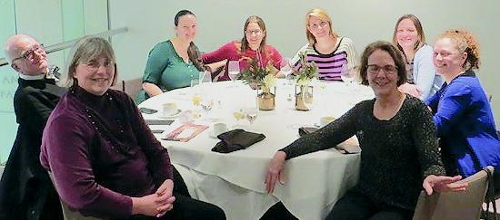
2016 holiday staff outing and lunch at Boston's Museum of Fine Arts. Clockwise L to R: Lolly Robinson, Roger Sutton, Katie Bircher, Shoshana Flax, Katrina Hedeen, Cynthia Ritter, Elissa Gershowitz, and Martha Parravano.
EG: It sounds like that’s something both of you are very proud of. What other things are you proud of in your work?
AS: When we found new creators, at the beginning of their careers: Jon Scieszka, Lane Smith, Sharon Creech, Mildred D. Taylor, Peter Sís. Then we were able to make a difference in their creative work.
But you never always get authors or books right. Paul Heins once said to me: “Anita, you’re going to make a lot of mistakes. Just don’t make the same mistake twice. If you miss Chris Van Allsburg’s first book, be sure you take a serious look at his second.” Bertha Mahony Miller understood that: great creators need praise singers. Maurice Sendak — even in his later years, when he’d already accomplished so much — valued the attention of the Horn Book. I was glad to be part of a supportive community for really creative people. And I am also grateful to have lived long enough to see the Horn Book’s hundredth anniversary!
RS: I am most proud of having kept the Horn Book going through two tumultuous things: the first being the publication of Harry Potter [in 1997 in the UK and 1998 in the U.S.] and the subsequent changes to the industry; and the second was when the owners of the Horn Book decided they no longer wanted to own the Horn Book, and I successfully moved it over to Media Source’s ownership [in 2009] and kept it going.
AS: The whole industry changed with Harry Potter. As I teach the history of children’s book publishing in the Children’s Literature department at Simmons University, 1998 is the dividing year in contemporary publishing. In that fast-growing, post–Harry Potter industry, Roger, I truly admired your spirited defense of LGBTQ+ books. Because of it, publishers were able to take chances on more of these authors, knowing that the Horn Book would defend the best of them.
RS: We also both saw a big shift to children’s books being sold in bookstores and opening up that market from, predominantly, libraries.
AS: Yes — I saw that when I was in marketing at Houghton. I would take people like James Marshall up and down the West Coast to all the children’s independent stores. Those stores were starting to open up all over the country, giving children’s and YA books a boost in retail sales. They were, in fact, much like the store run by Bertha.
EG: I was going to say — the Bookshop for Boys and Girls, which led to the Horn Book.
AS: Always ahead of her times, Bertha stood on the right side of history.
RS: One of my happiest days at the office was when Arnold Manthorne, Bertha’s grandnephew, told me that Bertha was up in heaven laughing because she was so happy at what the Horn Book was today.
EG: It has been a fantastic first hundred years—and on to the next!
 From the May/June 2024 special issue of The Horn Book Magazine: Our Centennial. For more Horn Book centennial coverage, click here. See also our September/October 1999 75th Anniversary issue and Virtual History Exhibit.
From the May/June 2024 special issue of The Horn Book Magazine: Our Centennial. For more Horn Book centennial coverage, click here. See also our September/October 1999 75th Anniversary issue and Virtual History Exhibit.
 Single copies of this special issue are available for $15.00 including postage and may be ordered from:
Single copies of this special issue are available for $15.00 including postage and may be ordered from:
Horn Book Magazine Customer Service
magazinesupport@mediasourceinc.com
Full subscription information is here.
RELATED
ALREADY A SUBSCRIBER? LOG IN
We are currently offering this content for free. Sign up now to activate your personal profile, where you can save articles for future viewing.





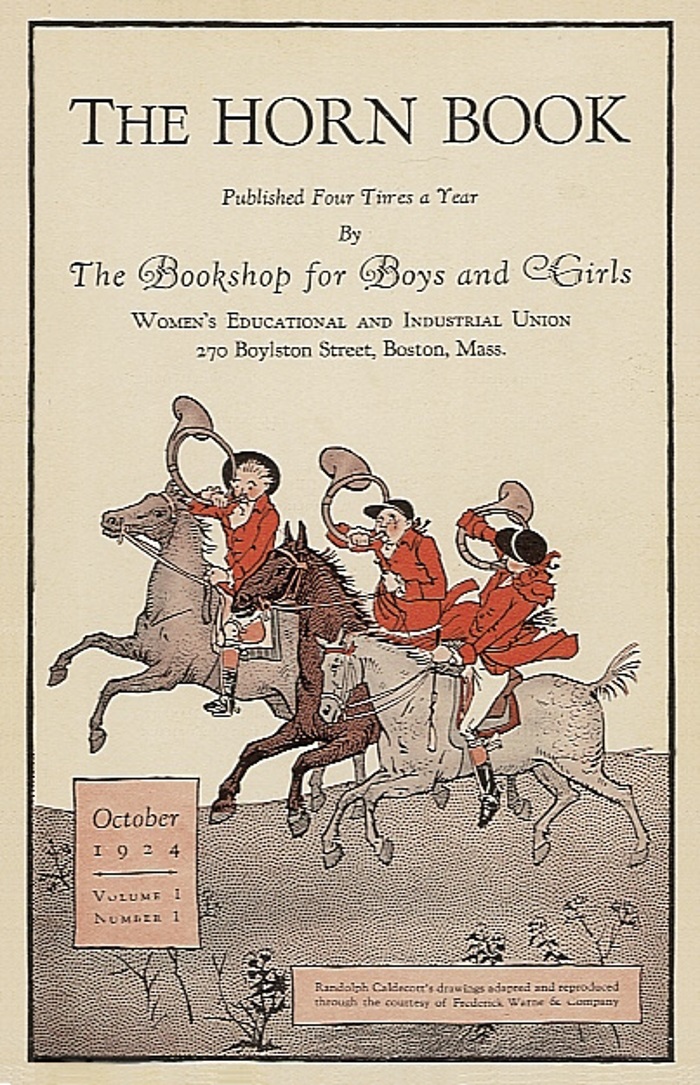
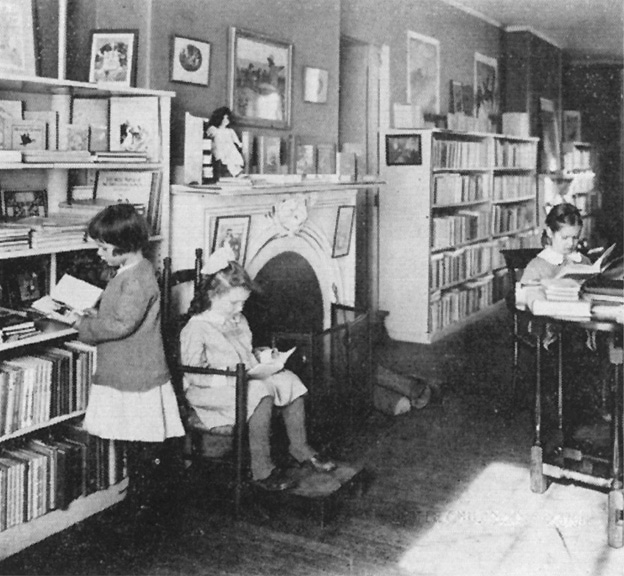
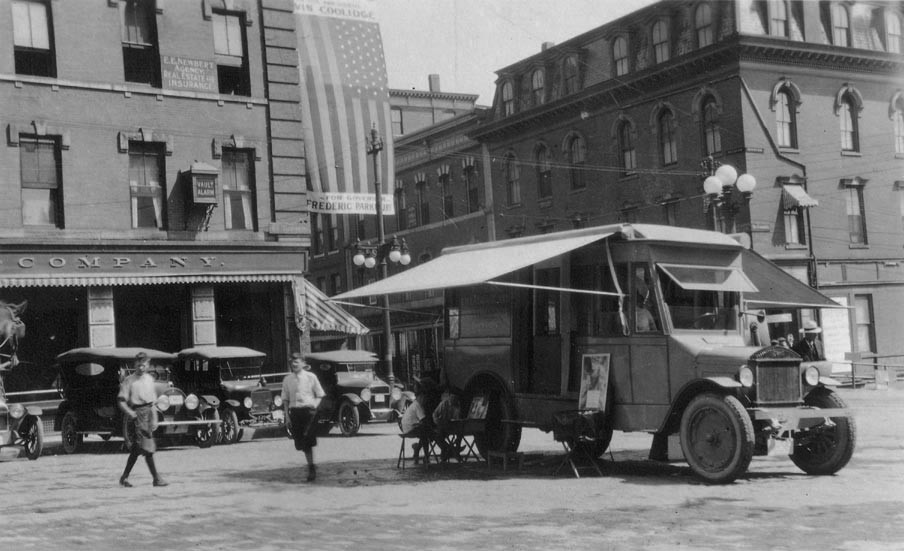
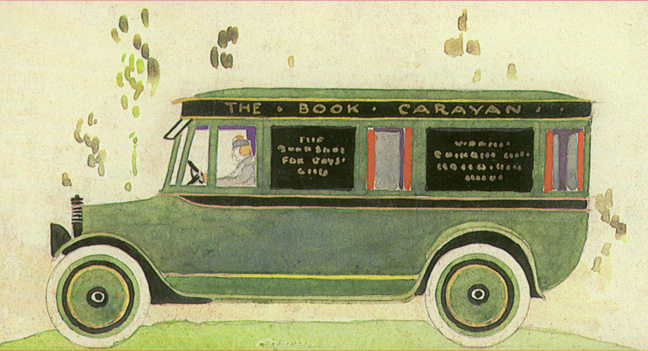





Add Comment :-
Be the first reader to comment.
Comment Policy:
Comment should not be empty !!!